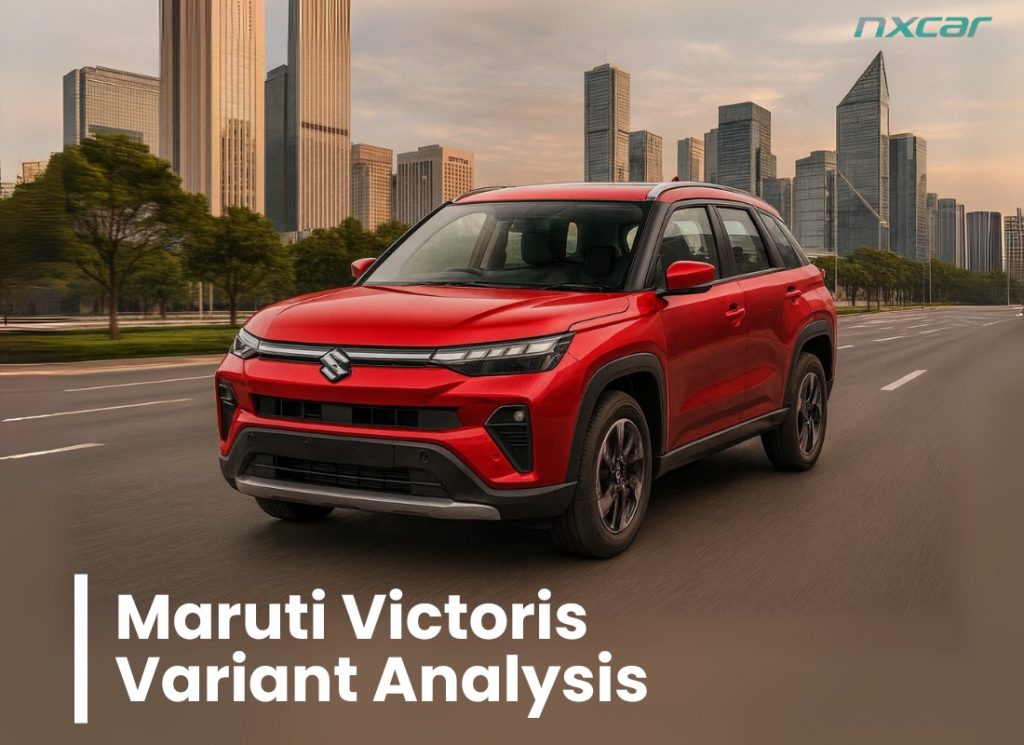Buying a new SUV should feel exciting, but it often leaves buyers overwhelmed. Endless trim levels, scattered brochures, and cryptic spec sheets can transform a joyful purchase into a stressful puzzle. That’s the challenge facing anyone eyeing Maruti’s latest contender—the Victoris. With multiple powertrain options, layered features, and trim names that blur together, it’s easy to wonder: Which one is genuinely worth the money?
Now imagine making the wrong call. You stretch your budget for a higher variant only to discover that half the “premium” features go unused. Or worse, you save a little upfront and later regret missing essential conveniences like advanced safety tech, better infotainment, or even basic comfort features. Buyers across the country fall into this trap every year—lured by showroom glitz, but left second-guessing their decision on the drive home.
That’s precisely why a clear, structured breakdown matters. Instead of relying on generic advice, it’s time to dissect the Victoris with precision. From the well-equipped base model to the technology-laden top trims, every variant has a unique personality and price-to-value ratio. This isn’t just about picking an SUV; it’s about ensuring your hard-earned money goes into a package that enhances everyday usability, long-term ownership, and yes, driving pride.
In this feature, you’ll find Maruti Suzuki Victoris Variants Explained in detail—an honest, comprehensive guide designed to cut through the clutter and spotlight the trim that best aligns with your lifestyle, budget, and aspirations.
Key Updates & Positioning
- Breadth of choice: Petrol (MT/AT), strong-hybrid (AT), CNG (MT), and limited 4WD with petrol-AT on top trims.
- Big on safety: Claimed 5-star BNCAP with ESC, 6 airbags, HSA, TCS, all-disc brakes standard.
- Tech-first cabin: 10.1-inch HD touchscreen (upper trims), 10.25-inch full-color cluster (wider availability), 360° camera, radar-based ADAS (petrol-AT only), Dolby Atmos audio, wireless phone projection, connected features.
- Efficiency focus: Strong ARAI figures across powertrains; CNG retains usable boot space—a rarity.
- Caveats: No spare wheel, no EPB on manuals or hybrid, ADAS limited to petrol-AT.
Pros & Cons at a Glance
What stands out
- Clean, squared-off SUV styling; plush, well-trimmed interiors
- Exceptionally wide feature spread for a Maruti, even on the base variant
- Strong efficiency across all engines; CNG with real luggage practicality
- Deep service network lowers running and maintenance anxiety
Where it falls short
- 1.5L NA petrol lacks punch vs turbo rivals; 5-speed MT feels dated
- Hybrid uses a 3-cylinder; refinement isn’t best-in-segment
- ADAS only with petrol-AT; hybrid misses both ADAS and electronic parking brake
- No spare wheel; some premium misses (rear curtains, seat memory)
Variant Walkthrough & Who Should Buy What
LXI (Base)
The LXI variant is where the Victoris story begins, and it’s not your typical stripped-down base model. It packs a surprisingly generous list of features straight out of the box—wireless Android Auto/Apple CarPlay, electronic stability control, 6 airbags, all-disc brakes, and even a 7-inch touchscreen. Add to that a tilt and telescopic steering wheel, split-folding rear seats, and rear AC vents, and you get an SUV that feels practical and family-ready from day one.
Of course, it doesn’t tick every box. You’ll have to live without a height-adjustable driver seat, vanity mirrors, tyre pressure monitoring system (TPMS), and LED projector headlamps. Still, for those who want an affordable SUV without compromising on safety and core conveniences, the LXI is a compelling starting point. It is particularly suited for budget-conscious buyers who want essentials, not frills.
VXI
Step up to the VXI and the Victoris starts to feel more polished. This trim introduces TPMS, a rear camera for easier parking, cruise control, and power-folding mirrors. Rear passengers benefit from faster USB-C charging ports, while automatic buyers get an electronic parking brake with auto hold. Hybrid buyers also unlock exclusive touches like a 10.25-inch digital instrument cluster and selectable drive modes, adding tech appeal.
But the VXI doesn’t completely escape compromises. It still skips LED projector headlamps, a rear washer/wiper, and a more powerful audio setup. Its true worth will hinge on pricing. If Maruti keeps the price gap small over the LXI, this variant could be a smart middle ground. If priced aggressively, however, it risks losing value. In short, the VXI is best for buyers set on entry-level automatics or hybrids without stretching to the more balanced ZXI.
ZXI / ZXI (O)
This is the sweet spot in the Victoris lineup. The ZXI adds the features that matter most for daily use and long-term satisfaction. You get LED projector headlamps, a powered tailgate with gesture control, wireless charging with cooling, and an auto-dimming rear-view mirror. Cabin quality takes a leap forward with a soft-touch dashboard and UV-cut glass, while functionality improves with washer-wipers and fog lamps. The ZXI (O) adds the much-demanded panoramic sunroof, making it more aspirational.
For most buyers, this is the variant that strikes the perfect balance between price and practicality. It doesn’t feel stripped-down like the LXI, nor does it reach the price-heavy heights of the ZXI Plus. One important note: the CNG powertrain maxes out at the ZXI, so buyers wanting factory CNG won’t have access to the sunroof-equipped ZXI (O). Still, for petrol and hybrid buyers, this is the most well-rounded choice.
ZXI Plus / ZXI Plus (O)
At the top of the lineup sits the ZXI Plus, and it’s the Victoris in full showcase mode. This variant adds advanced driver assistance systems (ADAS) on petrol automatics, including adaptive cruise control, lane-keep assist, and forward collision warning. Tech lovers will appreciate the 360-degree camera, head-up display, multi-color ambient lighting, and a premium surround sound system with a subwoofer. Comfort gets a boost with ventilated front seats and an 8-way powered driver seat.
The ZXI Plus also introduces 4WD availability on petrol-AT, a rare offering in this segment, making it appealing for those who travel frequently in hilly or challenging terrains. However, it’s also the most expensive trim, and its value proposition depends heavily on Maruti’s pricing strategy. Buyers should ask themselves whether they’ll truly use the ADAS features or whether they’re better served by the already-rich ZXI.
In essence, the ZXI Plus / ZXI Plus (O) is designed for tech-max buyers who want every available feature and enthusiasts seeking a capable 4WD SUV without stepping into a different segment altogether. For everyone else, the ZXI remains the smarter long-term choice.
Quick Comparison Table
| Variant | Powertrains Available | Key Additions Over Previous Trim | What It Misses | Best For |
|---|---|---|---|---|
| LXI (Base) | 1.5 Petrol-MT, 1.5 CNG-MT | Wireless CarPlay/Android Auto, 6 airbags, ESC, all-disc brakes, 7-inch touchscreen, tilt & telescopic steering, split rear seats, rear AC vents | Height-adjustable driver seat, vanity mirrors, TPMS, LED headlamps | Budget buyers who want core safety & essentials |
| VXI | 1.5 Petrol-MT/AT, 1.5 CNG-MT, 1.5 Hybrid-AT | TPMS, rear camera, cruise control, power-folding mirrors, rear USB-C, EPB (AT only), hybrid-only drive modes & 10.25-inch cluster | LED projector headlamps, rear wiper/washer, stronger audio system | Entry-level automatic or hybrid buyers |
| ZXI / ZXI (O) | 1.5 Petrol-MT/AT, 1.5 CNG-MT, 1.5 Hybrid-AT | LED projector headlamps, powered tailgate, wireless charger, auto-dimming IRVM, UV-cut glass, soft-touch dashboard, washer-wiper, fog lamps; (O) adds panoramic sunroof | Rear window curtains, richer audio, ventilated seats | Sweet spot for balance of features & pricing |
| ZXI Plus / (O) | 1.5 Petrol-MT/AT/4WD, 1.5 Hybrid-AT | ADAS (Petrol-AT only), 360° camera, ambient lighting, ventilated seats, HUD, premium audio w/ subwoofer, 8-way power driver seat | Memory function, ADAS not on hybrid, rear curtains | Tech lovers & 4WD seekers willing to pay premium |
The One to Choose (Editor’s Pick)
ZXI / ZXI (O) is our all-round recommendation in this Maruti Suzuki Victoris Variants Explained guide.
It bundles the real-world must-haves (LED lighting, wireless charger, auto-dimming mirror, washer-wiper, soft-touch cabin, powered tailgate) at a typically compelling Maruti mid-trim price. Add (O) if you specifically want a panoramic sunroof.
Alternates by need
- Strict budget (Petrol/CNG): LXI
- Entry automatic or hybrid on a budget: VXI (only if priced sensibly)
- Feature-max & ADAS (Petrol-AT): ZXI Plus / ZXI Plus (O)
- Occasional trails / hilly terrain: ZXI Plus / ZXI Plus (O) 4WD (await pricing)
Expected Prices & Booking Advice
Petrol-Manual & CNG-Manual (Expected)
| Powertrain | Variant | Exp. Price (₹ lakh) | Our Take |
|---|---|---|---|
| 1.5 Petrol-MT | LXI | 10.0 | Budget pick; very complete base |
| VXI | 11.0 | Wait for price; may be weak VFM | |
| ZXI | 13.0 | Top recommended | |
| ZXI (O) | 13.5 | For sunroof seekers | |
| ZXI Plus | 15.5 | Consider only if price is sharp | |
| ZXI Plus (O) | 16.0 | As above | |
| 1.5 CNG-MT | LXI | 11.0 | Budget CNG with usable boot |
| VXI | 12.0 | Wait for price | |
| ZXI | 14.0 | Top recommended (CNG ceiling) |
Booking tip: If you’re CNG-curious, book ZXI (CNG) early; it’s the highest CNG trim.
Petrol-Automatic & Hybrid-Automatic (Expected)
| Powertrain | Variant | Exp. Price (₹ lakh) | Our Take |
|---|---|---|---|
| 1.5 Petrol-AT | VXI | 12.4 | Sensible entry automatic |
| ZXI | 14.4 | Top recommended | |
| ZXI (O) | 14.9 | Add sunroof if you must | |
| ZXI Plus | 17.5 | Price sensitive | |
| ZXI Plus (O) | 18.0 | Fully-loaded; check value | |
| ZXI Plus 4WD | 18.5 | Buy for need, not novelty | |
| ZXI Plus (O) 4WD | 19.0 | As above | |
| 1.5 Hybrid-AT | VXI | 15.0 | Entry hybrid, efficiency-first |
| ZXI | 16.9 | Top recommended (Hybrid) | |
| ZXI (O) | 17.4 | Sunroof option | |
| ZXI Plus | 18.5 | Consider only if priced well | |
| ZXI Plus (O) | 19.0 | Feature-full but expensive |
Important constraints:
- ADAS available only on Petrol-AT (upper trims).
- EPB not available on manual and not on Hybrid.
- No spare wheel across variants.
Core Feature Progression (Highlights)
| Area | LXI | VXI | ZXI / ZXI (O) | ZXI Plus / (O) |
|---|---|---|---|---|
| Safety | 6 airbags, ESC, HSA, all-disc | +TPMS, camera | +Auto headlamps, washer-wiper | +ADAS (Petrol-AT), front sensors, RCTA |
| Infotainment | 7″ touchscreen, wireless AA/CarPlay | +Tweeters | Larger HD screen, 10.25″ cluster | Dolby Atmos, HUD |
| Convenience | Keyless go, tilt/telescopic, rear AC | +Cruise control, EPB (AT only), faster USB-C | Wireless charger (cooled), power tailgate, auto-dimming IRVM | Ventilated seats, 8-way power driver |
| Exterior | Halogen projector, 17″ steel | Body-coloured ORVM/handles | LED projector, fogs, UV-cut, alloys | Machined alloys, ambient lighting |
| Drivetrain | Petrol-MT / CNG-MT | +Petrol-AT / Hybrid-AT | Same as VXI (+ sunroof on (O)) | +4WD (Petrol-AT) |
Engines & Transmissions: Where Victoris Stands
Base NA Petrol Comparison
| Model | Engine | Power | Torque | Gearbox | ARAI FE (indicative) |
|---|---|---|---|---|---|
| Victoris | 1.5L NA | 103 PS @ 6000 | 139 Nm @ 4300 | 5MT / 6AT | Up to ~21 km/l |
| Creta/Seltos | 1.5L NA | 115 PS | 144 Nm | 6MT / CVT | ~17–20 km/l |
| Elevate | 1.5L NA | 121 PS | 145 Nm | 6MT / CVT | ~15–18 km/l |
| Astor | 1.5L NA | 110 PS | 144 Nm | 5MT / CVT | ~15–17 km/l |
Takeaway: Victoris trails in output but counters with class-leading efficiency.
Against Turbo-Petrol Rivals
| Model | Engine | Power | Torque | Gearbox | FE (indicative) |
|---|---|---|---|---|---|
| Victoris | 1.5L NA | 103 PS | 139 Nm | 5MT/6AT | ~21 km/l |
| Curvv | 1.2L Turbo | 120 PS | 170 Nm | 6MT/7DCT | ~19–20 km/l |
| Kushaq/Taigun | 1.0/1.5 TSI | 115–150 PS | 178–250 Nm | 6MT/6AT/7DSG | ~18–19 km/l |
Takeaway: Performance isn’t its forte; efficiency and ownership cost are.
Top-Spec Powertrains
| Model | Engine | Power | Torque | Auto | FE (Auto) |
|---|---|---|---|---|---|
| Victoris | 1.5L Hybrid | 116 PS (sys) | 141 Nm (e-motor assist) | e-CVT | Up to ~28–29 km/l |
| Creta/Seltos Turbo | 1.5L Turbo | 160 PS | 253 Nm | DCT/CVT | ~18 km/l |
| Kushaq/Taigun 1.5 | 1.5 TSI | 150 PS | 250 Nm | 7DSG | ~19 km/l |
Takeaway: Hybrid excels in economy; turbo rivals deliver stronger performance.
Dimensions & Practicality
| Model | L x W x H (mm) | Wheelbase (mm) | Ground Clearance | Boot (L) | Tyres |
|---|---|---|---|---|---|
| Victoris | 4360 x 1795 x 1655 | 2600 | TBA | 439 (Petrol) / 320 (CNG) | 215/60 R17 |
| Creta | 4330 x 1790 x 1635 | 2610 | ~190 mm* | 433 | 16–18″ |
| Elevate | 4312 x 1790 x 1650 | 2650 | ~220 mm | 458 | 17″ |
| Kushaq | 4225 x 1760 x 1612 | 2651 | ~188 mm | 385 | 16–17″ |
*Estimated where indicated.
Practical win: Victoris CNG retains 320L of usable luggage space.
Colour Palette
Monotone: White, Silver, Grey, Black, Blue, Red, Green
Dual-Tone: Blue/Black, Red/Black, Silver/Black
Quick Buyer Paths
- City runner, low running costs: Hybrid ZXI (or VXI Hybrid if budget-tight).
- Family road-trips, value & features: ZXI (O) Petrol-AT.
- High usage + fixed routes: ZXI CNG for efficiency without killing boot space.
- Tech & safety max (Petrol-AT): ZXI Plus (O) for ADAS + 360° + ventilated seats.
- Occasional off-road / hills: ZXI Plus (O) 4WD (price-dependent).
Final Word
If there’s just one insight to carry away from this Maruti Suzuki Victoris Variants Explained guide, it’s this: the ZXI / ZXI (O) trim is the most balanced choice for the vast majority of buyers. This variant strikes the ideal equilibrium between price and practicality, delivering everyday essentials like LED projector headlamps, wireless charging, auto-dimming IRVM, and a powered tailgate, while layering in comfort touches that actually enhance daily use. With the optional panoramic sunroof on the ZXI (O), it even satisfies the aspirational itch without forcing you into the steep price climb of the top-most trims.
For those stretching every rupee, the LXI is a surprisingly complete entry point. Despite being the base model, it offers six airbags, ESC, wireless phone integration, and a touchscreen—all of which make it a strong pick for budget buyers who don’t want to compromise on safety. It’s the rational option for families seeking maximum value at the lowest entry ticket.
The VXI sits in a tricky middle ground. While it introduces conveniences like cruise control, TPMS, and hybrid-only features such as drive modes, its appeal depends heavily on how Maruti positions its pricing. If the premium over the LXI is minimal, the VXI becomes an attractive stepping stone—especially for those looking at an affordable automatic or hybrid entry. But if the gap grows too wide, the ZXI quickly outshines it in sheer value-for-money.
For technology enthusiasts and feature hunters, the ZXI Plus (O) is the no-compromise option. It brings ADAS, ventilated front seats, a head-up display, premium audio with subwoofer, and ambient lighting. Add in 4WD capability on petrol automatics, and it becomes the variant for buyers who want everything modern in their SUV, or who plan to venture beyond smooth highways. That said, it’s also the most expensive pick—making it worthwhile only if you truly value and will use the extra equipment.
In the CNG lineup, ZXI is the ceiling and the smart bet. It ensures you get a usable 320L boot space with all the meaningful features intact, while avoiding the compromises of lower trims. Hybrid buyers will also find their sweet spot in the ZXI, which offers the perfect blend of efficiency and technology without saddling you with the diminishing returns of pricier trims.
In short:
- Budget-focused? Choose LXI.
- Waiting for pricing surprises? Keep an eye on VXI.
- Balanced, everyday value? Go for ZXI / ZXI (O).
- Feature-max, tech-savvy, or 4WD need? Step up to ZXI Plus (O).
- CNG buyers? Stick with ZXI.
- Hybrid seekers? Again, ZXI is the bullseye.
This structure ensures every buyer—from cost-conscious families to gadget-loving professionals—has a clear path. And if you’re weighing between closely matched trims like the ZXI, ZXI (O), and ZXI Plus (O), a focused comparison or even a long-term cost-of-ownership analysis can seal the decision with confidence.




